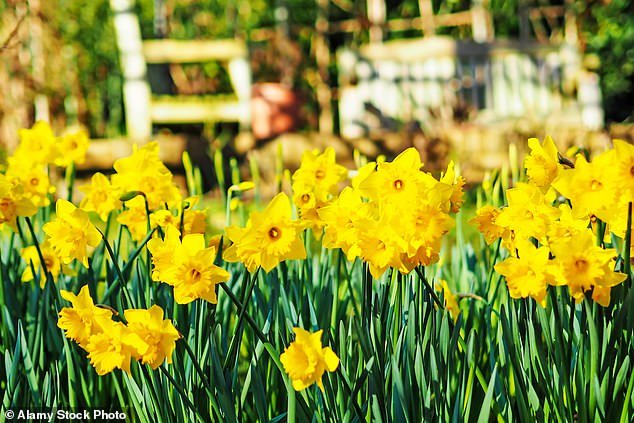Dance with the daffs: Get outside and enjoy the vivid displays of our golden trumpets
- Nigel Colborn says now is the time to get outside and enjoy daffodil varieties
- British gardening expert advises storing bulbs somewhere cool and dry
- He adds daffodils thrive in a wide range of soils and should be planted in autumn
Oh gosh, is it daffodil time already? Suddenly there are golden trumpets everywhere, heralding spring with brazen visual fanfares. With the days still short and March weather so fickle, it’s wonderful to see so many in flower.
For centuries, trumpet daffodils and their more elegant sisters, narcissus, have been nurtured in gardens. No other bulb group is so widely planted. For the next two months, they’ll cheer up gardens, parks and road verges.
Daffodils are often overplanted and can smother more modest spring flowers. But even the most garish displays are short-lived, so enjoy them while you can.
Despite being fleeting in bloom, there are hundreds of daffodil and narcissus varieties.
Vibrant spring blooms: There are 150 species and many varieties of daffodils
Some flower in February – or even earlier. Others such as late jonquils and pheasant-eye narcissus bloom in May.
A few wild species even flower in autumn. But apart from November-blooming paperwhite narcissus, they’re tiny and lack garden value.
This is not the time to plant narcissus – that’s done in autumn. Neither can you buy bulbs. The task for now is to get outside and enjoy as many varieties as you can. Then you can compose a shopping list and order your bulbs for autumn.
CAMERA AT THE READY
With 150 species and thousands of varieties, choosing is never easy. It helps if you snap photos with a smartphone.
If you know the variety names, record those, too. Then, when reading through catalogues, you’ll find matching varieties.
The range is impossibly huge.
Sizes run from tiddly miniatures such as the mini-jonquil Baby Moon or multi-headed dwarf Hawera, to big trumpet daffs such as King Alfred or the white Mount Hood.
Between those extremes are varieties for every taste.
When perusing a catalogue, you will also find other, even more tempting choices. That’s what makes browsing such fun, especially on a wet summer day.
When your bulbs are delivered, store them somewhere cool and dry, and plant them in early autumn.
HAPPY PLACE
Daffodils thrive in a wide range of soils. Most are fully hardy, surviving midwinter freezes or spring frosts. Trumpet types perform in sun or gentle shade. Smaller cup narcissus need more light.
Trumpet daffodils love humusrich, moisture-retentive soil. Single bulbs divide repeatedly, developing clumps. Dig those up every few years, when the leaves have died. Break them up and re-plant the larger bulbs.
Most smaller cupped narcissus enjoy similar conditions but with more light. They also benefit from being lifted and divided every few years to prevent overcrowding.
On shady, slightly damper soils, N. cyclamineus varieties are lovely choices, with sweptback petals and narrow trumpets. Strong varieties include yellow Peeping Tom, white Dove Wings, and a ravishing yellow and cream Swallow.
For mass planting in grass, you can’t beat our native Narcissus pseudonarcissus – the lakeside daffodils that inspired Wordsworth. That’s my personal favourite and in my garden, always the first to blow its trumpet.
